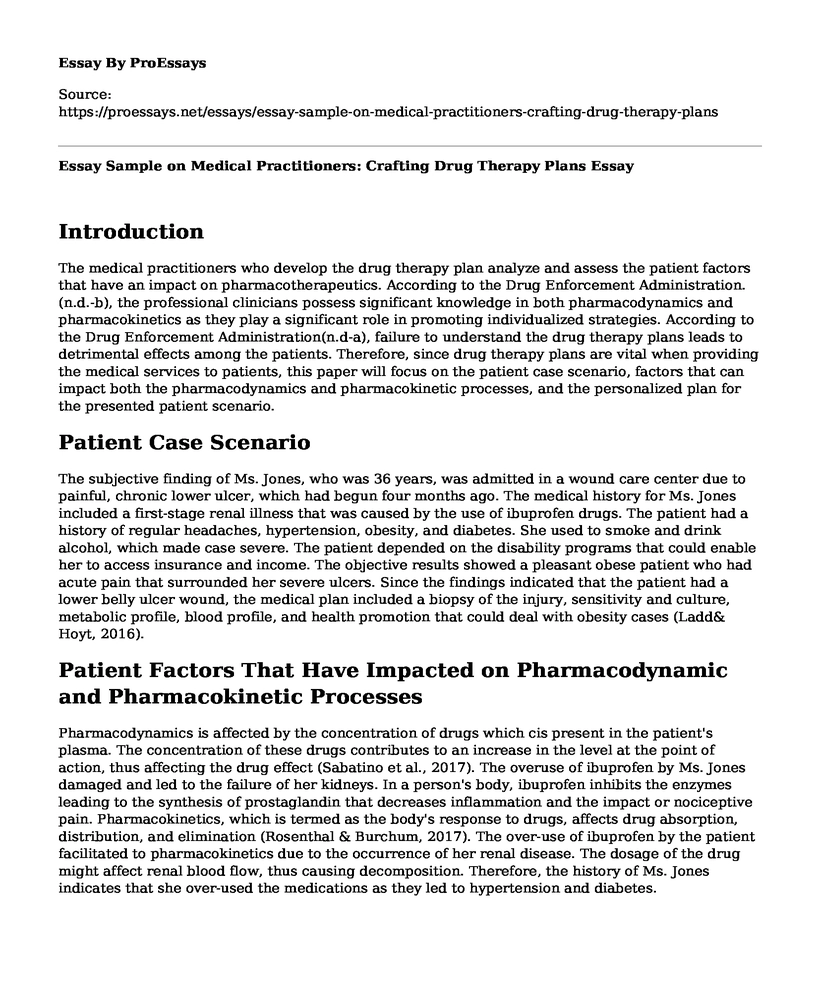Introduction
The medical practitioners who develop the drug therapy plan analyze and assess the patient factors that have an impact on pharmacotherapeutics. According to the Drug Enforcement Administration. (n.d.-b), the professional clinicians possess significant knowledge in both pharmacodynamics and pharmacokinetics as they play a significant role in promoting individualized strategies. According to the Drug Enforcement Administration(n.d-a), failure to understand the drug therapy plans leads to detrimental effects among the patients. Therefore, since drug therapy plans are vital when providing the medical services to patients, this paper will focus on the patient case scenario, factors that can impact both the pharmacodynamics and pharmacokinetic processes, and the personalized plan for the presented patient scenario.
Patient Case Scenario
The subjective finding of Ms. Jones, who was 36 years, was admitted in a wound care center due to painful, chronic lower ulcer, which had begun four months ago. The medical history for Ms. Jones included a first-stage renal illness that was caused by the use of ibuprofen drugs. The patient had a history of regular headaches, hypertension, obesity, and diabetes. She used to smoke and drink alcohol, which made case severe. The patient depended on the disability programs that could enable her to access insurance and income. The objective results showed a pleasant obese patient who had acute pain that surrounded her severe ulcers. Since the findings indicated that the patient had a lower belly ulcer wound, the medical plan included a biopsy of the injury, sensitivity and culture, metabolic profile, blood profile, and health promotion that could deal with obesity cases (Ladd& Hoyt, 2016).
Patient Factors That Have Impacted on Pharmacodynamic and Pharmacokinetic Processes
Pharmacodynamics is affected by the concentration of drugs which cis present in the patient's plasma. The concentration of these drugs contributes to an increase in the level at the point of action, thus affecting the drug effect (Sabatino et al., 2017). The overuse of ibuprofen by Ms. Jones damaged and led to the failure of her kidneys. In a person's body, ibuprofen inhibits the enzymes leading to the synthesis of prostaglandin that decreases inflammation and the impact or nociceptive pain. Pharmacokinetics, which is termed as the body's response to drugs, affects drug absorption, distribution, and elimination (Rosenthal & Burchum, 2017). The over-use of ibuprofen by the patient facilitated to pharmacokinetics due to the occurrence of her renal disease. The dosage of the drug might affect renal blood flow, thus causing decomposition. Therefore, the history of Ms. Jones indicates that she over-used the medications as they led to hypertension and diabetes.
Personalized Plan Care for the Case Scenario
Ms. Jones's case scenario could have been averted through patients' education, health promotion, prevention, and consideration of effective drug therapies. The prevention of the renal effects on Ms. Jones could involve lab monitoring of the renal functions. Through education, the clinicians would determine the dosage, risks, and management of pain experienced by the patient (Institute for Safe Medication Practices, 2017). Therefore, pain management approaches can involve consultations with pain management clinics and rheumatologists.
References
Drug Enforcement Administration. (n.d.-a). Code of federal regulations. Retrieved from https://www.deadiversion.usdoj.gov/21cfr/cfr/1300/1300_01.htm
Drug Enforcement Administration. (n.d.-b). Mid-level practitioners authorization by state. Retrieved from http://www.deadiversion.usdoj.gov/drugreg/practioners/index.html
Institute for Safe Medication Practices. (2017). List of error-prone abbreviations, symbols, and dose designations. Retrieved from https://www.ismp.org/recommendations/error-prone-abbreviations-list
Ladd, E., & Hoyt, A. (2016). Shedding light on nurse practitioner prescribing. The Journal for Nurse Practitioners, 12(3), 166-173. doi:10.1016/j.nurpra.2015.09.17
Rosenthal, L., & Burchum, J. (2017). Lehne's Pharmacotherapeutics for Advanced Practice Providers-E-Book. Elsevier Health Sciences. Retrieved from https://evolve.elsevier.com/cs/product/9780323447836?role=student
Sabatino, J. A., Pruchnicki, M. C., Sevin, A. M., Barker, E., Green, C. G., & Porter, K. (2017). Improving prescribing practices: A pharmacistled educational intervention for nurse practitioner students. Journal of the American Association of nurse practitioners, 29(5), 248-254. doi:10.1002/2327-6924.12446
Cite this page
Essay Sample on Medical Practitioners: Crafting Drug Therapy Plans. (2023, Apr 10). Retrieved from https://proessays.net/essays/essay-sample-on-medical-practitioners-crafting-drug-therapy-plans
If you are the original author of this essay and no longer wish to have it published on the ProEssays website, please click below to request its removal:
- Essay Sample: Teenage Pregnancies and the Duty of Public Health Practitioners in Canada
- Patient Testimony: Motor Vehicle Accident
- An Argumentative Essay on Vaccine
- Critical Differences Between DPN and PhD or DNS Programs Paper Example
- Disaster Management in the City of Lufkin
- Essay Example on Aged People Suit Best in Upcountry: Physical Attributes at Play.
- Free Essay Example: Impact of the Pandemic on the Economy







